Metrics Overview
Metrics throughout Customer.io show you how well your messaging strategies are working or if there’s anything unexpected happening. We provide a variety of views so you can learn about everything from workspace-wide performance to Campaign journeys.
What does Customer.io measure?
We primarily focus on two kinds of metrics. You may find a combination of both of these things on the Dashboard, Analysis, and Campaign Overview pages. While they often correspond, it’s important to note that we measure two different things.
- Campaign journeyA person or data object’s path through your campaign. metrics, which help you learn about how people progress through campaigns.
- Message/deliveryThe instance of a message sent to a person. When you set up a message, you determine an audience for your message. Each individual “send”—the version of a message sent to a single member of your audience—is a delivery. metrics, which help you determine how well your messages perform.
On your Dashboard, we also calculate:
- Segment membership metrics, which show how membership in segments changes over time.
- Test metrics, showing how your A/B tests have performed and which entry in the test won.
- Link metrics, which help you understand which of your links your audience clicks most often.
How we calculate campaign journey and message metrics
A journey is the instance of a campaign that a person experiences. A message is an individual message in the campaign. So, a person who receives a message might be in progress in their campaign journey, but have opened or clicked a message in that campaign. Their interaction with the message is done, but they’re still working their way through the journey.
Metrics do not report actions on the date they occur. Instead, metrics are reported against the date a journeyA person or data object’s path through your campaign. or a messageThe instance of a message sent to a person. When you set up a message, you determine an audience for your message. Each individual “send”—the version of a message sent to a single member of your audience—is a delivery. is created.
It may be helpful to think of metrics as an answer to the question: of messages and/or journeysA person or data object’s path through your campaign. created on a particular date, how many achieved a particular status?. This also means that corresponding metrics for journeys and messages may report on different dates because journeys can take a while and messages are more immediate.
For example, imagine that you have a campaign that sends messages over a five day period. A person enters the campaign on January 1st; they open and convert based on the last message—sent and received on January 6th. The converted metric for this journey is reported on the 1st—because the journey, created on the 1st, has converted. The converted metric for the message is reported on January 6th, because the message was created on the 6th.
Message Performance and Delivery Metrics
Customer.io generates the following metrics to determine the performance of your messages. By default, we calculate metrics based on the number of deliveriesThe instance of a message sent to a person. When you set up a message, you determine an audience for your message. Each individual “send”—the version of a message sent to a single member of your audience—is a delivery. that successfully make it to recipients, though you can change this setting if you don’t send messages using our default sending domain and you don’t send delivery metrics to Customer.io from your delivery provider.
Your message was successfully sent from Customer.io to the delivery provider. It is their responsibility to ensure the message is properly delivered, and we’re waiting for further information to determine if the user interacted with it. Delivered means that we’ve received confirmation from the delivery provider that a message was delivered to the recipient’s email service provider (ESP). The user opened your message. For email, we count the open when the recipient’s email client loads an invisible image (tracking pixel) or when the recipient clicks one of the links in the email. If a customer has images disabled in their email client and an open is tracked based on a click event, the “Opened Email” and the “Clicked Email” events will show as having occurred at the same time. To track opens for push notifications, you need to send us an event. If you are not sending the “opened” events for push notifications but are using tracked links in the push content, the “Opened Push” and “Clicked Push” will occur at the same time based on the tracked click. The Open Rate is calculated by dividing the total number of opened messages by the number of messages delivered, measuring the percentage of your messages that people opened. As an increasing number of email clients provide privacy settings that let people block tracking pixels, open metrics may appear misleadingly low. You can disable email open tracking at the workspace level, so that you aren’t distracted by potentially unreliable open rates. In general, we recommend that you focus on Converted and Clicked metrics instead; these metrics reliably measure customer actions based on your messages.Sent
Delivered
Opened
Clicked
The user clicked on any link in a message where link tracking was enabled. We also track clicks on individual links.
Click-to-open
This measures the rate at which people click tracked links in messages that they open, and is calculated by dividing Clicked metrics by Opened metrics.
Converted
A message is marked as converted when an end-user meets your conversion goal and that was the last message received before the conversion goal was met, by default. Learn more about how conversions work.
Unsubscribed
A message is counted as unsubscribed when a user unsubscribes from all messages. You can read more about how global unsubscribes work in Customer.io.
Unsubscribed from topics
Unsubscribed from topics counts each subscription topic that a user unsubscribed from through a delivered message. As such, you may see a percentage above 100; say you have 4 subscription topics and 5 messages are delivered to five users. Two users unsubscribe from 3 topics each (6 total). We would divide this by the number of delivered messages (5) to get 1.2 or 120% unsubscribed from topics. You can read more about how our subscription center works in Customer.io.
Marked-as-spam
For emails, this means that the end-user marked the email as ‘Spam’ via their email service provider. All subsequent emails are then marked “suppressed.”
Failed
A failed message never made it to the delivery provider. We have a separate article to help you diagnose why your message never left Customer.io.
Bounced
For email, this means the user’s email address wasn’t valid. This could be a hard bounce (usually a permanent issue like a non-existent email address) or a soft bounce (a temporary issue like a full mail box). In the case of hard bounces for emails, subsequent messages to those addresses will be given the “suppressed” status.
Suppressed
A message is marked as suppressed if:
- the email address we tried to send it to was previously a hard bounce (a permanent failure such as an invalid address), or
- the end-user marked any previous email message as spam. In this case, all subsequent email messages after the “spam” mark will be marked as “suppressed”.
We don’t record metrics for messages that are more than 6 months old.
If someone opens your message more than 6 months after you sent it, we won’t attribute an open to your message. We ignore metrics for older messages to keep your workspace running quickly.
Set the denominator for message metrics
By default, we calculate message metrics based on the number of messages delivered. This helps you gauge message performance based on the number of messages that actually reach your audience’s inboxes.
However, you should change your metrics to calculate based on the number of messages sent if:
- You don’t use our default sending domain
- You don’t send Delivery metrics to Customer.io from your delivery provider.
To change the denominator (Delivered or Sent) for your metrics:
- Go to Settings > Workspace Settings > Email and click Settings.
- Go to the Custom SMTP tab and click Delivered or Sent to determine how your metrics are calculated.
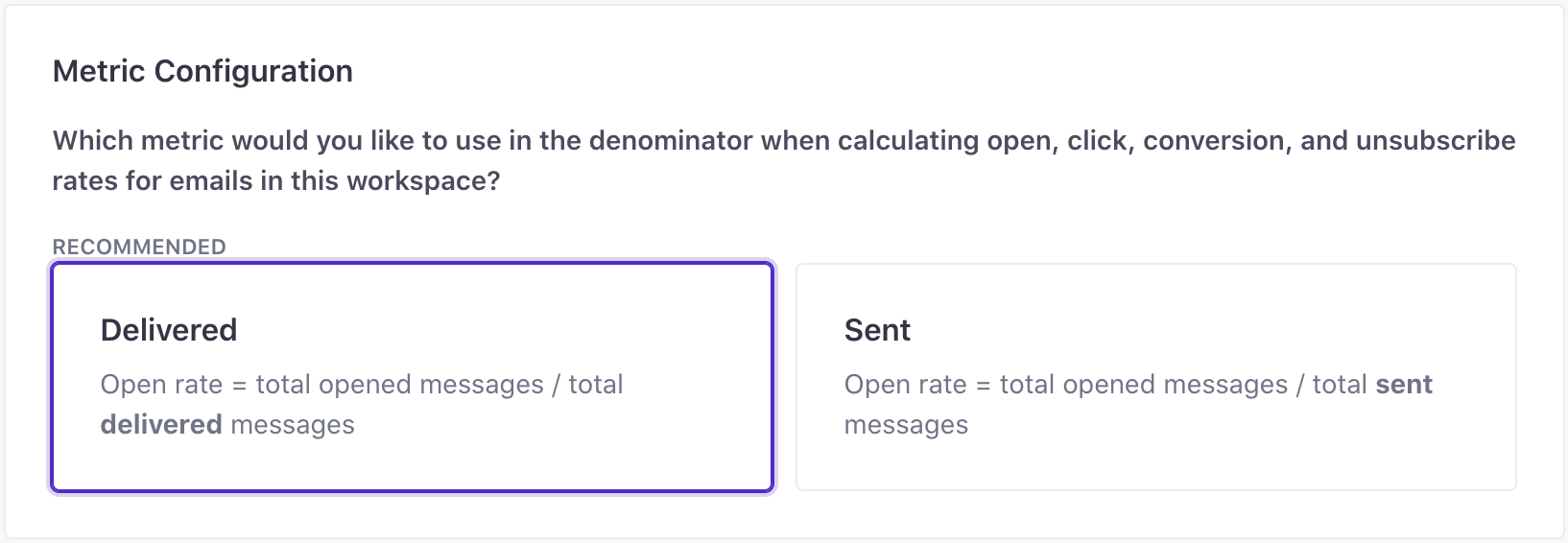

What we track for each message type
Different types of messages produce different metrics. If we can’t track a metric for a channel, you’ll either see a ‘-’ or 0.0% in its place, depending on the location in Customer.io.
| Delivered | Opened | Clicked | Converted | Bounced | Suppressed | Spammed | Unsubscribed | Unsubscribed from topics | |
|---|---|---|---|---|---|---|---|---|---|
| check_circle | check_circle | check_circle | check_circle | check_circle | check_circle | check_circle | check_circle | check_circle | |
| Twilio SMS | check_circle | highlight_off | highlight_off | check_circle | check_circle | check_circle | highlight_off | highlight_off | highlight_off |
| Customer.io Push | check_circle1 | check_circle1, 2 | highlight_off | check_circle | check_circle | highlight_off3 | highlight_off | highlight_off | highlight_off |
| In-App | highlight_off | check_circle | check_circle | check_circle | highlight_off | highlight_off | highlight_off | highlight_off | highlight_off |
| Slack Message | highlight_off | highlight_off | check_circle | highlight_off | highlight_off | highlight_off | highlight_off | highlight_off | highlight_off |
| Webhook | highlight_off | highlight_off | check_circle | check_circle4 | highlight_off | highlight_off | highlight_off | highlight_off | highlight_off |
Journey Metrics
A journey is the instance of a campaign workflow that an individual person experiences.
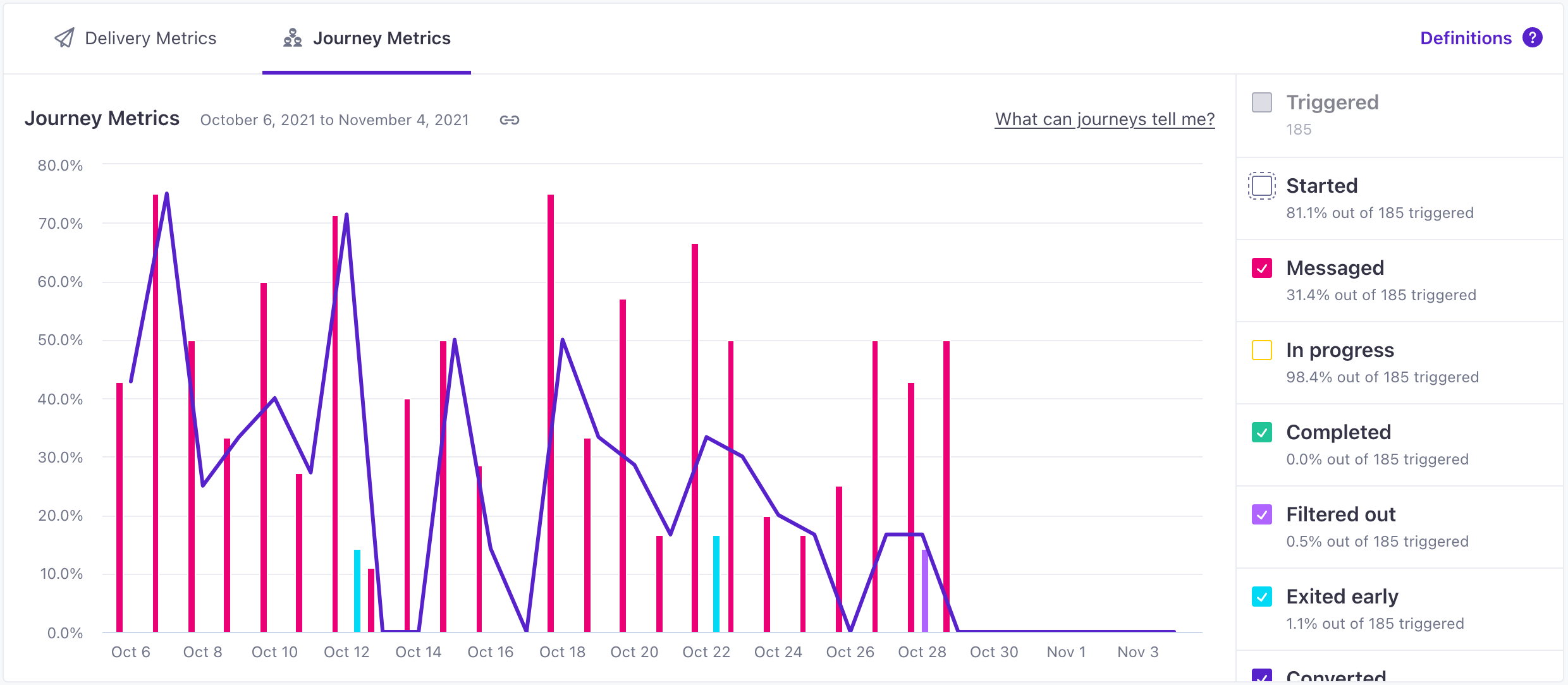

Journey metrics are calculated based on the total number of people who triggered your campaign within the selected time frame. However, a campaign trigger doesn’t necessarily represent someone who experienced your campaign. People can trigger a campaign, but be filtered out before they start the campaign (Started) or receive a message (Messaged).
People who matched the campaign trigger. People who trigger your campaign can be filtered out before they start it, representing a discrepancy between this metric and Started. You may want to compare this metric to Started to determine if the scope of your campaign is too wide or your filter is too narrow. You can only see this metric when you use the raw Count. In the Journey Metrics export, this metric is People who matched the campaign trigger, filter(s) and completed a non-delay action. Because you can potentially filter out people after they meet your campaign trigger, the Started metric effectively represents the total number of people eligible to experience your campaign. People who experienced a message action in your campaign—an email, SMS, push notification, webhook, or Slack message. This includes drafted messages. People who have Started your workflow, and are waiting in a delay in your workflow, but have not yet exited, converted, or been filtered out. People who completed your campaign workflow by making their way to an exit action. People who matched your campaign trigger, but did not experience a journey/workflow. These are people who exited the campaign before experiencing a Started or Messaged state due to your campaign filters or other criteria during a delay action at the start of your campaign. In the Journey Metrics export, this metric is People who exited a campaign before completing an exit action. This may happen if a person stops matching the trigger and filter conditions while in a delay, their profile is deleted, or you manually remove them from a campaign. People who achieved the conversion goal for the campaign. People are “converted” when they enter or exit a designated segment in response to, or within a set time of, a delivery. If your campaign does not have a conversion goal, this metric is empty.Triggered
activated.Started
Messaged
In Progress
Completed
Filtered Out
never_activated.Exited Early
Converted
Links, Segments, and Tests
Your workspace Dashboard also shows information about your segments, links, and tests.
Links
The Links card shows the total link clicks for every link in the workspace. This allows you to view click metrics for links over any time range, and across any channel.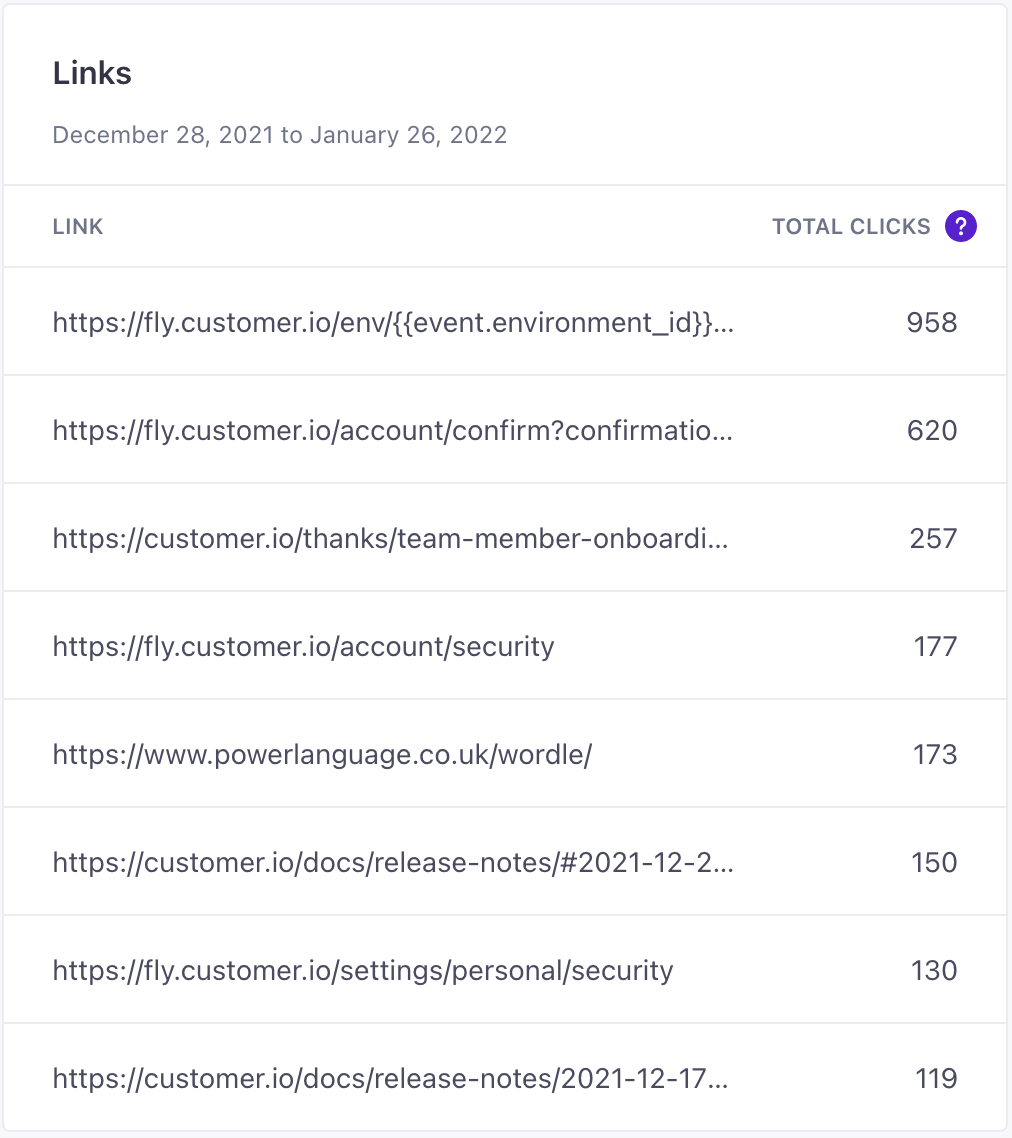

Segments
The Segments card allows you to see how membership counts for specific Segments have changed over time. You can choose any Segment you’d like from the drop down and your selection will be saved the next time you view the page. Pin the two Segments you care most about and keep an eye on them every time you login.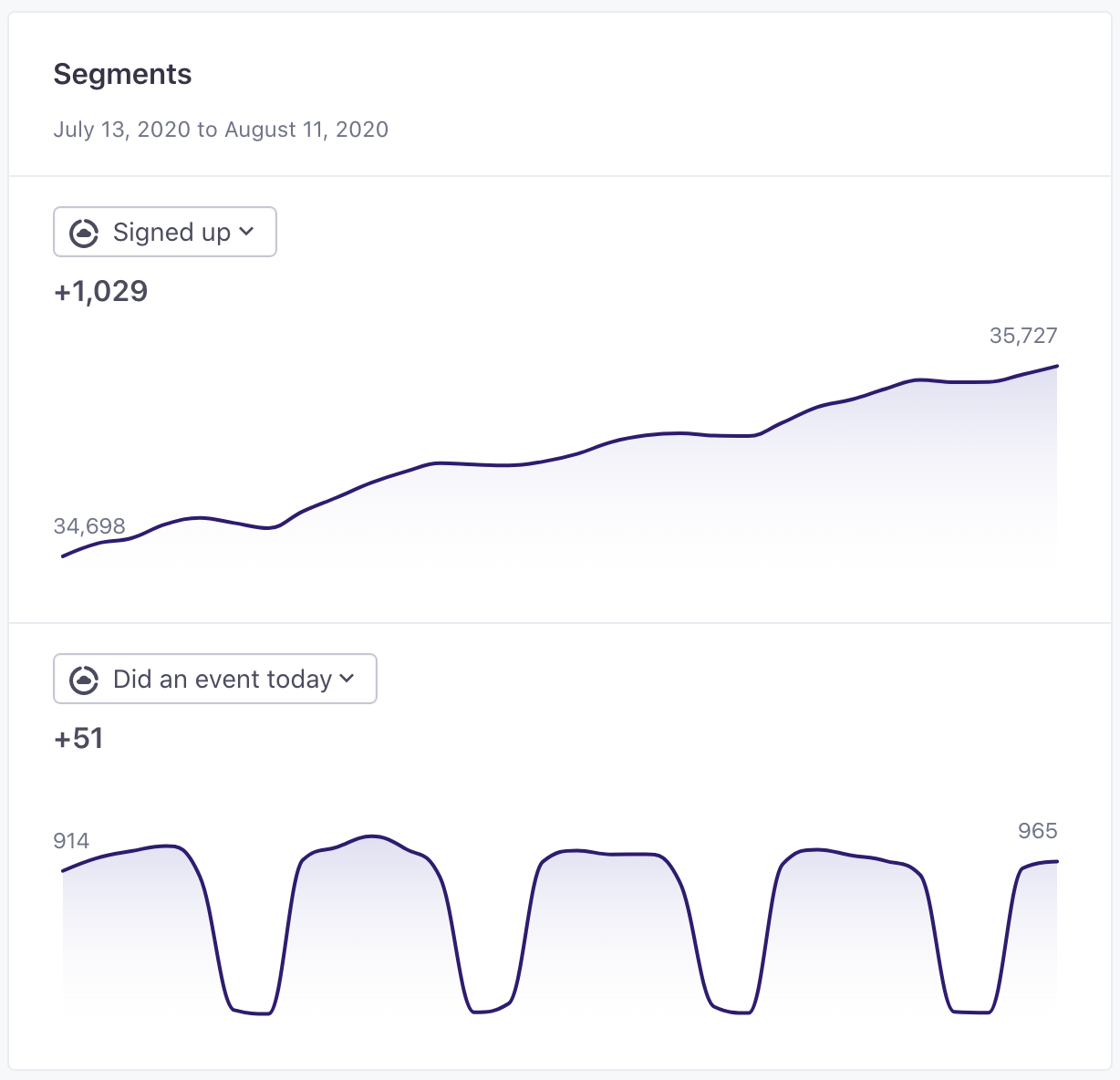

Tests
The Tests card shows all running tests in the workspace at the current time. This helps highlight tests that have been running longer than necessary, or that might be ready for completing based on their stats. Dive directly into the details of the test by clicking it in the list.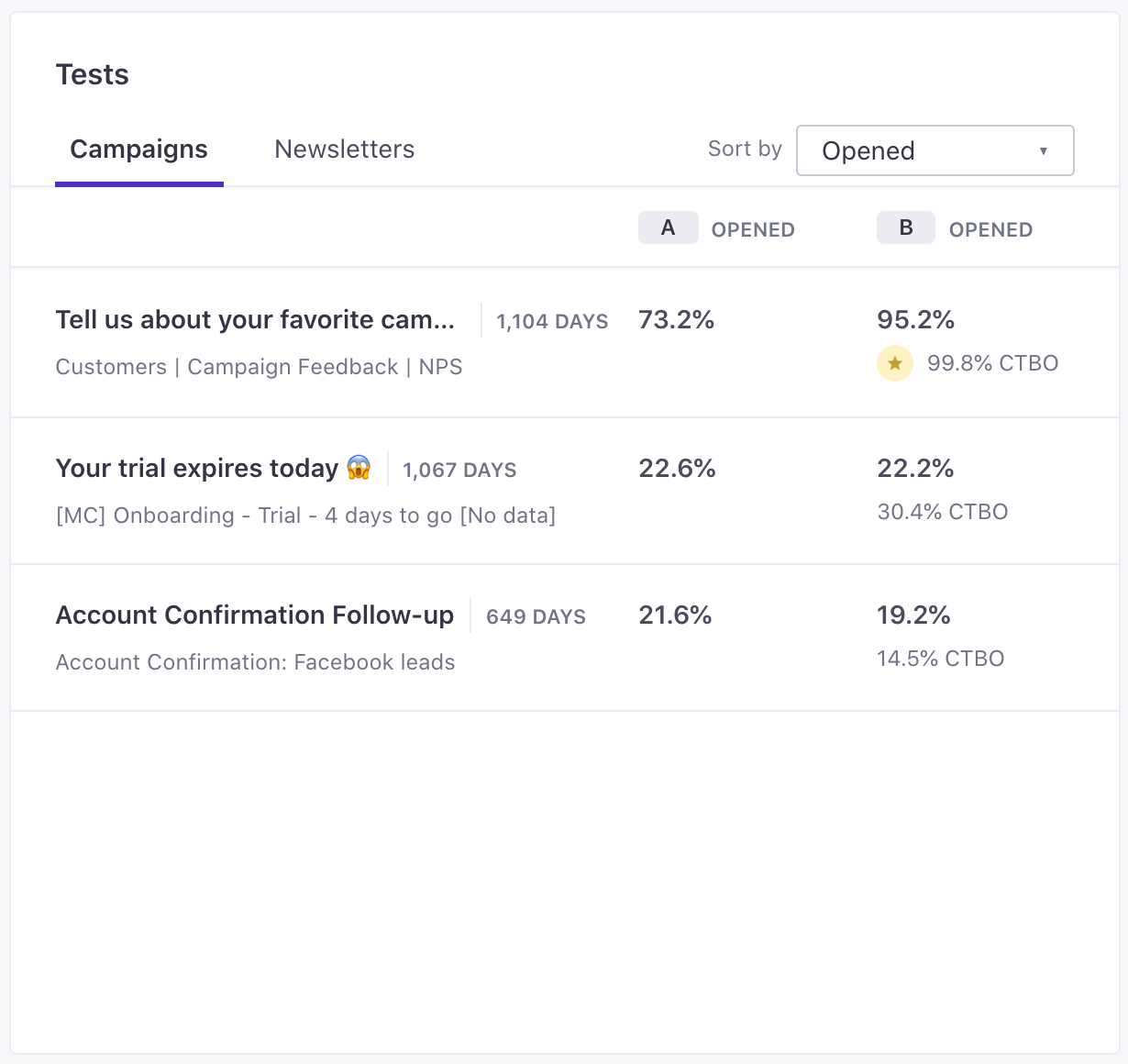

Newsletter Metrics
After you send a newsletter, you can see the metrics on the Overview tab. While campaigns and broadcasts can report journeyA person or data object’s path through your campaign. metrics, newsletters are a single broadcast send, and only produce message delivery metrics.

